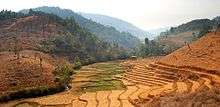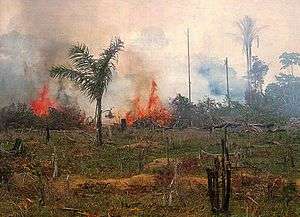Deforestation in Thailand
Deforestation in Thailand refers to the conversion of its forested land to other uses. Deforestation numbers are inexact due to the scope of the issue. According to the Royal Forest Department (RFD) in 2019, Thai forests cover 31.6% (102 million rai) of Thailand's landmass.[1] The department claims that forest coverage grew by 330,000 rai in 2018, an area equivalent in size to the island of Phuket.[2] A year earlier, an academic claimed that, since 2016, forested area has declined by 18,000 rai, a significant improvement over the period 2008–2013, when a forested million rai were lost each year.[3] In 1975, the government set a goal of 40% forest coverage—25% natural forest and 15% commercial forest—within 20 years. To achieve that target in 2018, 27 million rai would have to be afforested.[3]

Between 1945 and 1975, forest cover in Thailand declined from 61% to 34% of the country's land area. Over the succeeding 11 years, Thailand lost close to 28% of all of its remaining forests. This means that the country lost 3.1% of its forest cover each year over that period. An estimate by the World Wildlife Fund concluded that between 1973 and 2009, Thailand's forests declined by 43%.[4] The Thai Highlands in northern Thailand, the most heavily forested region of the country, were not subject to central government control and settlement until the second half of the 19th century when British timber firms, notably the Bombay Burmah Trading Corporation and the Borneo Company Limited, entered the teak trade in the late-1880s and early-1890s.[5] The Royal Forest Department, created in 1896 and headed by a British forester until 1925, sought to conserve the forests against the worst business practices of British, Thai, and Chinese timber firms who worked in the region.
During the 20th century, deforestation in Thailand was driven primarily by agricultural expansion,[6] although teak deforestation happened as a direct result of logging. Much of Thailand's recent economic improvement can be attributed to increased agricultural production for export. The country was able to increase production by clearing much of their forest and converting it to cropland.
The Thai government is beginning to emphasize forest restoration.[7]
History of Thai forest management
- On 18 September 1896 King Chulalongkorn established the Royal Forest Department under the Ministry of the Interior to manage forests and control revenue from the teak forests of northern Thailand.[8] A British forester from Burma, Herbert Slade, served as the first director of the department. From 1896–1925 the Thai government and British foresters and businesses created an "informal empire" over the teak forests of northern Thailand.
- In 1899 all forests were declared government property and all logging without payment to the Royal Forest Department was prohibited.
- In 1956 The Forest Industry Organization was established to establish governmental control of industrial uses of Thai forests.
- In 1962 the Thai government began to establish national parks and other forest conservation areas, their management under the jurisdiction of the Royal Forest Department. In the 1960s there was a large shift in forest use in Thailand. Deforestation began to increase, but not due to the commercial uses of teak forests in the north, but rather increased agricultural exports from the south.
- In the late-1960s the Thai government began to grant logging concessions, which required re-planting. They were poorly managed.
- A military coup in 1976 led to political instability. The military began to clear forests to suppress rebel forces who had settled in the forests for protection.
- Political instability left the government with little power to protect forests and illegal logging was pursued more heavily by villagers. During the height of illegal logging in Thailand it is estimated that somewhere between 50-75% of timber coming out of Thailand was obtained illegally.
- In the 1980s the government took steps to limit the speed at which Thailand's forests were disappearing. They set a target for 40% forest cover. To achieve this they initiated tree planting initiatives and leased some degraded forests to third parties to create logging plantations.
- In 1988 a flood in southern Thailand set in motion a complete ban on all commercial logging that was put in place in 1989. The government imposed a logging ban on 17 January 1989 in the form of a Cabinet Resolution (Order number 32/2532). This revoked all logging licenses in natural forests, effectively banning commercial logging, particularly in the uplands.[9]
Intact forest landscape
Intact forest landscape (IFL) "...is a seamless mosaic of forest and naturally treeless ecosystems with no remotely detected signs of human activity and a minimum area of 500 km2".[10] These areas must be undisturbed by human activities—they cannot be traversed by roads or deforested or harbor industrial operations. When any of these conditions apply, the ecosystems cease to be considered "intact". As of 2000 Thailand had 19,400 km2 of IFL, amounting to seven percent of its forested landscape. Over the period 2000-2013, 7.8% of Thailand's natural, intact forest landscape disappeared.[10]
Causes of deforestation in Thailand

Population growth
This is most evident in the northeast region of Thailand. The region is the most densely populated in the nation and has some of the least productive soils for agriculture. As populations increased, the need for food increased, and much forest land was cleared to increase food production.[11]
Agricultural policy
The Thai government put controls on the price of rice, which encouraged farmers to explore alternative crops. However, the largest impact agricultural policy had on deforestation was the construction of roads following World War II. These roads were built to help farmers bring food products from rural areas to urban centers. This encouraged farmers to move away from subsistence farming and begin to farm on a larger scale.[12]
Land ownership policy
Thailand is a nation where over 80% of land is owned by the richest 10% of the population[13] and where property rights are ambiguous and are often interpreted differently by the various branches of the Thai government. The inability of many Thai citizens to secure property has resulted in their turning to forests to find space to farm.[14] Often wildfires are deliberately set by local farmers, as well as by speculators who hire people to set forests on fire in order to claim land title deeds for the areas that have become "degraded forest".[15]
Illegal logging
Governmental officials in charge of protected areas have contributed to deforestation by allowing illegal logging and illegal timber trading. King Bhumibol Adulyadej has blamed the destruction of Thailand's forested areas on the greed of some state officials. This is evident in places such as large protected swathes of northern Nan Province that were formerly covered with virgin forest and that have been deforested even while having national park status.[16] Given that a mature, 30 year-old Siamese rosewood tree can fetch 300,000 baht on the black market, illegal logging is unlikely to disappear.[3][17]
Amelioration
Thailand's Ministry of Natural Resources and Environment's "20-Year Strategic Plan for the Ministry of Natural Resources and Environment (B.E. 2560 – 2579)" (2016–2036) addresses deforestion with its first strategy.[18] Among other goals, it aims to raise the nation's forest cover to 40%. Twenty-five percent would consist of "conserved forests" and 15% "commercial forests".[3]
See also
References
- "Forest area of Thailand, 1973-2018". Royal Forest Department. Retrieved 7 December 2019.
- Yonpiam, Chairith (7 December 2019). "Pareena probe must set a precedent" (Opinion). Bangkok Post. Retrieved 7 December 2019.
- Panyasuppakun, Kornrawee (11 September 2018). "Thailand's green cover in slow decline as 40% goal remains out of reach". The Nation. Retrieved 11 September 2018.
- Living Forests Report, Chapter 5. Gland, Switzerland: World Wildlife Fund. 2015. p. 35. Retrieved 28 Apr 2015.
Between 1973 and 2009 forests in the Greater Mekong declined by almost a third: 43 per cent in Vietnam and Thailand; 24 per cent in Lao PDR and Myanmar; and 22 per cent in Cambodia.
- Barton, G.A. and B.M. Bennett. (2010) Forestry as Foreign Policy: Anglo-Siamese Relations and the Origins of Britain's Informal Empire in the Teak Forests of Northern Siam, 1883–1925 34 (1): 65-86
- Delang, C.O. (2002) Deforestation in Northern Thailand: the Result of Hmong Swidden Farming Practices or Thai Development Strategies? Society and Natural Resources 15 (6): 483-501]
- Wipatayotin, Apinya; Theparat, Chatrudee (2012-02-28). "Govt to spend B3bn on forest restoration". Bangkok Post. Retrieved 6 Apr 2015.
- "Brief history of the Royal Forest Department". Royal Forest Department. Retrieved 4 May 2020.
- Lakanavichian, Sureeratna. "6. Impacts and effectiveness of logging bans in natural forests: Thailand". FAO. United Nations. Retrieved 23 December 2019.
- Potapov, Peter; Hansen, Matthew C; Laestadius, Lars (January 2017). "The last frontiers of wilderness: Tracking loss of intact forest landscapes from 2000 to 2013". Science Advances. 3 (1): e1600821. doi:10.1126/sciadv.1600821. PMC 5235335. PMID 28097216.
- Poffenberger, Mark (1990), Keepers of the Forest: Land Management Alternatives in South East Asia, Kumarian Press, ISBN 978-0-931816-81-9
- Myllyntaus, Timo; Saikku, Mikko (1999), Encountering the Past in Nature: Essays in Environmental History, Ohio University Press, ISBN 978-0-8214-1357-9
- Ekachai, Sanitsuda (2016-01-27). "Poor suffer as regime goes back to old ways". Bangkok Post. Retrieved 30 January 2016.
- Durrenberger, E. Paul (1996), State Power and Culture in Thailand, Yale University South East Asia Studies
- Samabuddhi, Kultida (2012-03-16). "PM misses the boat again on northern haze". Bangkok Post. Retrieved 22 Apr 2015.
- "King says greed a factor in floods". Bangkok Post. 2012-02-25. Retrieved 22 Apr 2015.
- Land, Graham (2016-01-08). "'More valuable than gold': Thailand's fight to save the Siamese Rosewood". Asian Correspondent. Retrieved 5 April 2016.
- "20-YEAR STRATEGIC PLAN FOR THE MINISTRY OF NATURAL RESOURCES AND ENVIRONMENT (B.E. 2560 – 2579)". MNRE. Retrieved 3 January 2018.
External links
- World Rainforest Movement: Thailand
- Urban Forest Archived August 26, 2012, at the Wayback Machine
